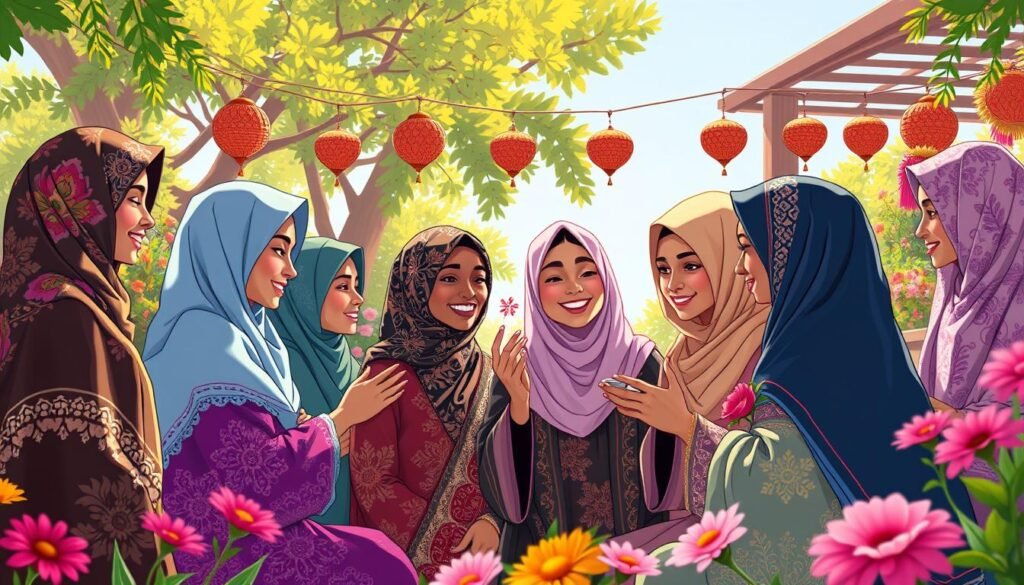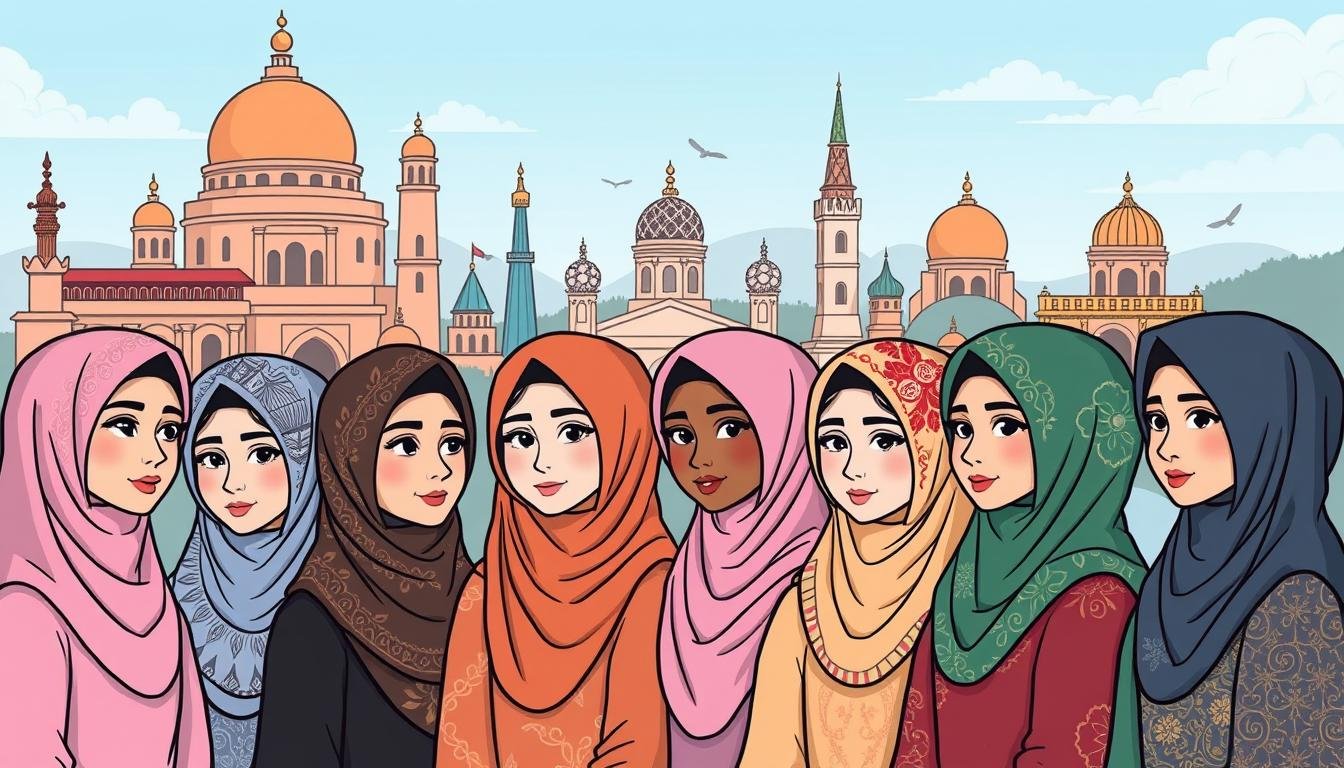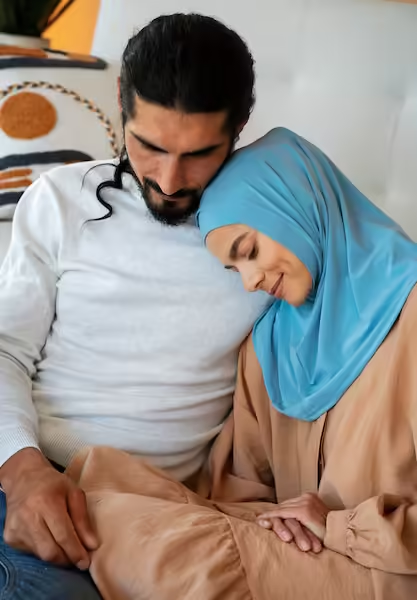What if a non-Muslim wants to wear a hijab? This question makes us think about the cultural meaning of religious clothes. For many, the hijab is more than a piece of fabric; it’s a symbol of who they are and what they believe.
The hijab is often misunderstood and can be politicized. It shows more than just personal choice. It’s about respect, appreciation, and how cultures interact.
Let’s look at the different views on a non-Muslim wearing a hijab. We’ll talk about the reasons for and against it. We’ll also discuss cultural appropriation and the challenges faced by those who choose to wear it.
We’ll see how the Muslim community reacts to this. And what it means for everyone involved. The hijab is more than fabric; it’s about our shared humanity. Understanding it needs a careful look.
The Cultural Significance of Hijab
The hijab is more than just a piece of cloth. It holds deep cultural meaning that goes beyond Islam. It shows up in many cultures around the world, carrying different meanings. These meanings include identity, resistance, and expression.
Looking into the history of hijab helps us see its true value. It shows how modesty and femininity are seen in many ways.
Historical Perspective on Head Coverings
Head coverings have been a part of many traditions for a long time. The hijab’s history is linked to cultures like Christianity and Judaism. For example, pictures of the Virgin Mary often show her wearing a head covering.
This shows that modesty through head coverings is not just for Islam. Many societies have their own versions of this practice. This shows the hijab’s roots go far beyond one religion.
Hijab in Different Cultures and Religions
In places like India and some European countries, head coverings are key to local customs. This shows how the hijab can mean different things to different people. It can represent spiritual beliefs or cultural heritage.
Exploring the hijab’s cultural significance reveals its rich history and community stories. It invites us to appreciate and understand its importance.
Can A Non Muslim Wear A Hijab
When non-Muslims wear hijab, it sparks many personal reasons and cultural views. They might do it to show support for Muslim women, enjoy the beauty of the hijab, or join cultural events. They face the challenge of how others see their choice, which opens up a chance for different groups to talk and learn from each other.
Understanding the Reasons for Wearing Hijab
People wear hijab for many reasons, not just because of religion. Some are drawn to its beauty, while others see it as a symbol in the Muslim world. On World Hijab Day, many non-Muslim women wear hijab to show respect and connect with Muslim women. Knowing about the long history of head coverings in different cultures adds more to this topic.
Perception Among Muslim Community
Muslims have different views on non-Muslims wearing hijab. Some see it as a way to bridge cultural gaps and show respect. But, others worry it might make the hijab’s religious meaning less important. Hijab wearers sometimes face harassment, showing the tough social issues and negative attitudes they meet.
Actions by extremist groups can make things worse, showing hostility to anyone, no matter their reasons. It’s important to keep talking to understand the many views on this topic.
Cultural Appropriation vs. Appreciation
Our world is getting more connected, and so is the talk about cultural appropriation and appreciation. It’s important to find a balance between celebrating different cultures and understanding their symbols. The hijab is a good example of this, as it can be both appreciated and misused.
We need to think about why we wear a hijab. This helps us understand its true meaning and value.
The Thin Line Between Appropriation and Respect
Wearing a hijab means we must know its cultural importance. Cultural appropriation happens when we take parts of a culture without knowing their history. This is bad when the hijab is seen just as a fashion item, not its deep meaning.
But, cultural appreciation is about respecting and learning. It means we study the hijab’s origins and the lives of those who wear it.
Edward Said talked about how our views shape our interactions in 1978. He said that shallow admiration can be a problem. So, we should value real connections with the hijab. For some, wearing it shows support for Muslim women, showing true appreciation.

Personal Motivations for Non-Muslims Wearing Hijab
More non-Muslim women are choosing to wear hijab. They see it as a way to express themselves and respect other cultures. The hijab is seen as both a fashion statement and a sign of solidarity with Muslim women.
Fashion Statements vs. Religious Observance
The hijab is now a big deal in fashion. People love its style and versatility. But, some worry about disrespecting Islamic laws or cultural values.
They want to understand the hijab’s true meaning. Wearing it for a short time doesn’t show what it’s like every day.
Solidarity with Muslim Women
Non-Muslim women wear hijab to show support for Muslims. World Hijab Day, started in 2013, brings people together. It helps fight prejudice against women.
Events like “Walk a Mile in Her Hijab” at Vernon Hills High School help too. They create empathy and understanding. Women learn a lot and grow closer to Muslim women’s experiences.
Some Muslims doubt the value of non-Muslims wearing hijab. They think it’s hard to truly understand their experience. But, talking to Muslim women can make a big difference.
Such actions can help break stereotypes and celebrate diversity. They show that non-Muslims can support and learn from Muslim women. This is important for building respect and understanding. Learn more about solidarity and cultural appreciation.
World Hijab Day: An Opportunity for Non-Muslims
World Hijab Day is celebrated on February 1st every year. It started in 2013. It invites people from different backgrounds to wear the hijab. This creates a space for cultural exchange and understanding.
Events around this day encourage non-Muslims to join. They learn about the challenges Muslim women face. It’s a chance to show solidarity and learn about the hijab’s cultural and religious importance.
Events and Participation
Before World Hijab Day, many events happen. They help people understand the hijab’s meaning. Social media users show their support for these efforts.
Wearing the hijab can start important talks about modesty and empowerment. There are local meetings and online campaigns. They aim to build understanding and awareness in communities.
By joining these events, non-Muslims can connect with Muslim women. This promotes solidarity and bridges cultural gaps.
Inspiring Stories from Non-Muslim Participants
Many non-Muslims share deep stories about World Hijab Day. They feel empowered and understand the hijab’s meaning better. They talk about challenging stereotypes and starting important talks with loved ones.
These stories highlight the value of respectful dialogue between faiths. They show the need for empathy in a diverse world. These experiences make World Hijab Day even more meaningful.
The Reactions of the Muslim Community
When non-Muslims wear the hijab, the Muslim community has mixed feelings. Many are thankful for the support, seeing it as a way to connect and understand each other better. This shows a desire to respect and learn from different cultures.
Supportive Voices Within Islam
Many Muslims support non-Muslims who wear the hijab. They view it as a sign of unity and respect for their culture. Events like the Christchurch shootings have shown people, like New Zealand’s Prime Minister, wearing the hijab to show solidarity.
This shows a growing trend of cultural understanding and exchange between communities.
Concerns and Considerations
But, there are also worries about wearing the hijab. Some fear it might be seen as not taking the hijab seriously. The case of Professor Larycia Hawkins at Wheaton College is an example of these challenges.
It’s important to understand the hijab’s true meaning. Real support goes beyond just wearing it. Talking about the hijab’s meaning can help build respect and understanding.

Challenges Faced by Non-Muslims Wearing Hijab
Wearing the hijab as a non-Muslim comes with its own set of challenges. These challenges come from how others see you and the reactions you might get. People might not understand or might even criticize you.
This situation highlights a complex mix of appreciation and cultural misuse. It raises important questions about respect and the true meaning of cultural practices.
Public Perception and Possible Backlash
How people see non-Muslims wearing hijab can change a lot. Some might wonder why you’re doing it, leading to accusations of cultural misuse. Others might criticize you harshly.
The pressure from society can be overwhelming. Wearing hijab often sparks talks about cultural sensitivity and respect. People might see it as a sign of tokenism, not real appreciation.
Understanding the Risks of Cultural Misunderstanding
There’s a big risk of cultural misunderstanding when non-Muslims wear hijab. Misconceptions can lead to negative stereotypes and even harassment. You might get caught up in debates about the hijab’s religious meaning.
It’s important for non-Muslims to think carefully before wearing hijab. Talking with people from different faiths can help. It can lead to a better understanding and more respectful conversations.
Different Religious Perspectives on Head Coverings
Head coverings are important in many religions. They show modesty and respect. Each religion has its own way of wearing them, influenced by culture, history, and faith.
Judaism
In Judaism, modesty is key. Many Jewish women wear sheitels, kosher wigs, or tichels, scarves over their hair. Men wear yarmulkes when praying to show respect for God.
Head coverings in Judaism are about being modest. They also follow religious rules.
Christianity
Christianity has different views on head coverings. Some groups follow the Bible and wear them during worship. Nuns wear veils to show devotion and obedience.
These practices remind Christians of humility and spiritual commitment.
Hinduism
In Hinduism, the pallu, a part of the saree, is used as a head covering. Women wear it over their heads to show respect, like in front of elders or during ceremonies. It shows devotion and honor.
This tradition celebrates modesty in women’s clothes.
Buddhism
Buddhism has many ways of wearing head coverings. Some Buddhist nuns wear them to show they’ve given up worldly things. This shows their commitment to their spiritual journey.
Across different Buddhist cultures, head coverings mean different things. But they often mean humility and respect.
The Empowerment of Choice and Self-Expression
The hijab is more than a piece of cloth. It’s a symbol of empowerment, showing the power of choice and self-expression. When someone, Muslim or not, chooses to wear it, they start a conversation that crosses cultural lines. This act of wearing the hijab is a way to show respect and understanding between different groups.
But, there are also challenges. People might face criticism or even hate for wearing the hijab. This shows how complex the hijab’s meaning can be. For some, it’s a sign of freedom and modesty. For others, it might feel like a limit on their freedom.
The hijab is a powerful symbol of choice and self-expression. For many women, wearing it is a way to show their independence and beliefs. By understanding and respecting these experiences, we can build a society that values cultural differences over judgment.
FAQ
Can a non-Muslim wear a hijab?
What are the primary reasons for wearing a hijab?
How do Muslims feel about non-Muslims wearing hijab?
What is the difference between cultural appropriation and appreciation regarding the hijab?
What is World Hijab Day, and how is it relevant?
What challenges do non-Muslims face when wearing a hijab?
How do different religions view head coverings?
How can wearing a hijab empower individuals?

Embracing Faith, One Insight at a Time!
The teachings of the Quran have always guided my path. With a deep passion for Islamic knowledge, I strive to blend the wisdom of tradition with the relevance of today, making the timeless messages of Islam accessible and meaningful for everyone.
Muslim Culture Hub is my platform to share historical insights and thought-provoking articles, exploring both well-known and lesser-discussed aspects of Islamic culture and beliefs. My mission is to create an inclusive online space where everyone can learn, strengthen their faith, and connect with the profound message of Islam.
Join the journey!
May peace be upon you.









